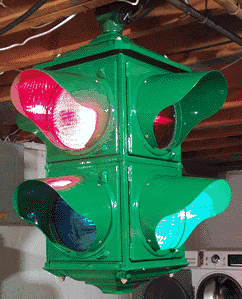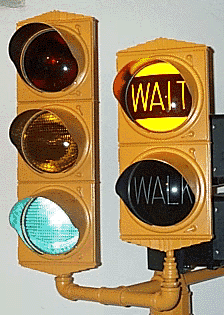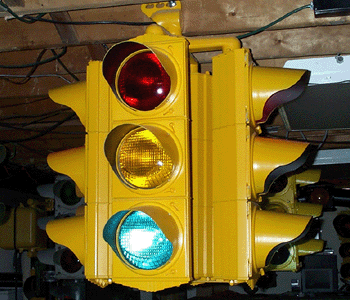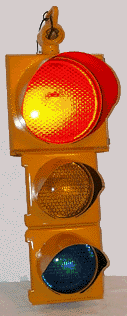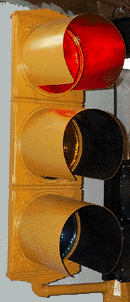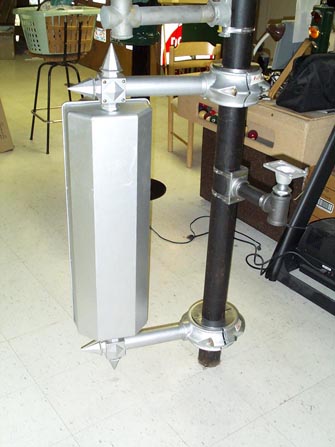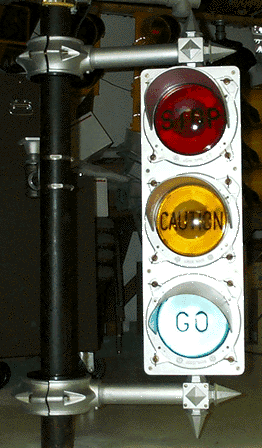Crouse Hinds Signals
|
This beacon was in good condition when it was acquired, except for the paint job being fairly weathered. Crouse Hinds made M type signals from 1952 until about 1960. The older D and DT type signals were much more ornate than the type M. The body of the M was actually made from a modified type D/DT mold. M and D/DT 4 way signal sections can be stacked and will fit together perfectly, although it would look rather unattractive to a signalfan! To see more pics of this beacon click here. |
|
In the early days of traffic signals
a lot of them were made without the amber indication that we are familiar with these days. A clearance time was still needed though so this was achieved by
both the red and green lights on for 3 or 4 seconds to show that the signal was about to give the right of way to the opposing traffic direction.
Another use of 4 way signals in this configuration is 4 way stop or stop/caution beacons with a wig/wag effect like with rail road crossing signals. There would be two lenses of the same color on each side and they flash back and forth creating a wig/wag effect between the top and bottom lenses.
|
|
| Here is a unigue 4 way beacon. It is a type M with 2 sections so you get a bouncing ball or a wig wag effect. It also sports a quick disconnect hanger, which is my only one in this collection. This hanger has a terminal strip in it so the signal can be "unwired" and removed without having to remove the hanger and wiring to the controller. |
This signal is a 3 way beacon, made
of single face Crouse Hinds DT, aka Art Deco sections.
The 3 individual sections did see service, but not in this
configuration. The 3 way hardware was purchased separate and the entire unit was
assembled this way after being added to this collection.
![]()
UPDATE! I took the 3 way beacon apart and made a drawbridge signal out of it.
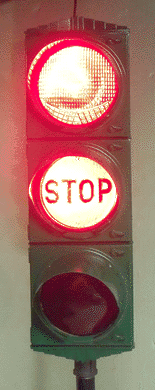
|
|
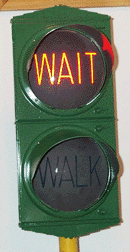
|
Known as Art Deco signals for the decorative top and bottom plates, also known as lever latch signals for the unique levers that hold the doors closed, these signals are very popular with collectors. Crouse Hinds called these model D and DT. The difference between the two mainly being the type of reflector frame inside, cast aluminum or stamped aluminum. |
|
|
Cast Aluminum signal with 12 inch red lens and 8 inch yellow and green lenses. The 8 inch sections are type M. The 12 inch section was very unpopular with traffic departments because of the spring latches that were used to hold the door shut. It wasn't very water tight and so its life was short lived. Click on the signal to see more pictures of this signal. |
Art Deco Style Aluminum Signal with 12 inch glass lenses. I have never seen 12 inch smiley lenses like the 8 inch signals have. Click on the picture to see inside this signal. |
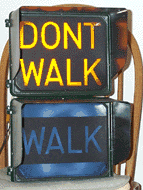 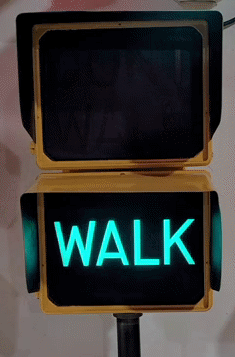 |
Here we have two Crouse hinds
type M pedestrian signals. These are unusual signals in that the lenses
are not square. They are rectangular. They measure 12 inches wide by 9
inches tall. WAIT lenses were first installed in these signals before
the DON'T WALK standard was introduced. The WAIT lens had a stripe just
like the WALK lens shown on the left. The signal on the right has rarer
red and green lenses. That signal came from Parma, Ohio.
|
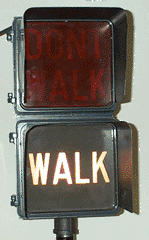 |
This is a 9 inch model R pedestrian signal. From this front view, it looks just like an Eagle 9 inch pedestrian signal, but the visors are not as long and don't tilt down like the Eagles do. It has glass lenses with the words embossed on the inside of the lenses. |
|
This is an old fixed face four direction signal. It came with the older, collectable smiley lenses. It was purchased from an online auction in April of 2000. These signals were produced in the 1940's and 1950's. Supposedly, this signal was originally used as a center of town traffic signal in Staunton, Virginia. These signals were also known as model D and DT like the art deco signals above. |
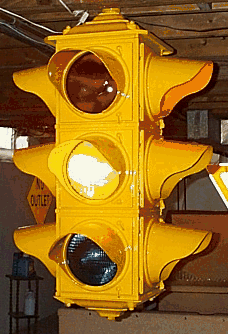 |
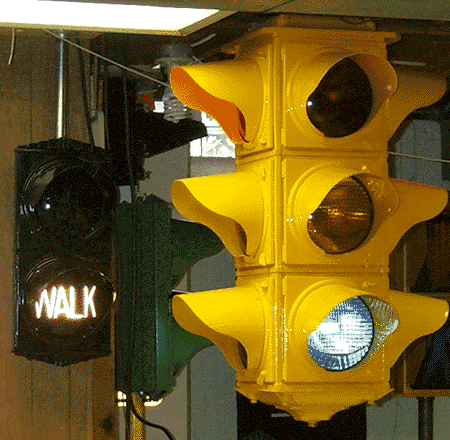 |
Here is another WAIT WALK signal. This signal has a WAIT lens that is all black except for the letters which are white. This lens is seen less than the one with the orange stripes and letters. This signal display works together with the Crouse Hinds 4 way shown here. |
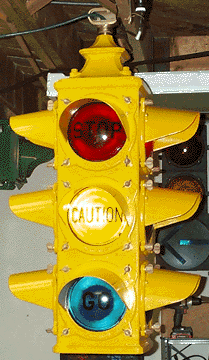 |
Here is a type T pagoda porthole 4 way signal. This signal was made from 1922-1925. The body of it is one solid casting. The roof is removable and is made of cast iron. The rest of the body is cast aluminum. This signal was in pretty good condition for it's age. The parts inside the signal that hold the glass reflectors were made of steel and were rusty. I found some rust remover and soaked all of the reflector holders in that and then repainted them. The body, doors, visors and roof of the signal were all powder coated. This signal weighs 137 pounds! |
